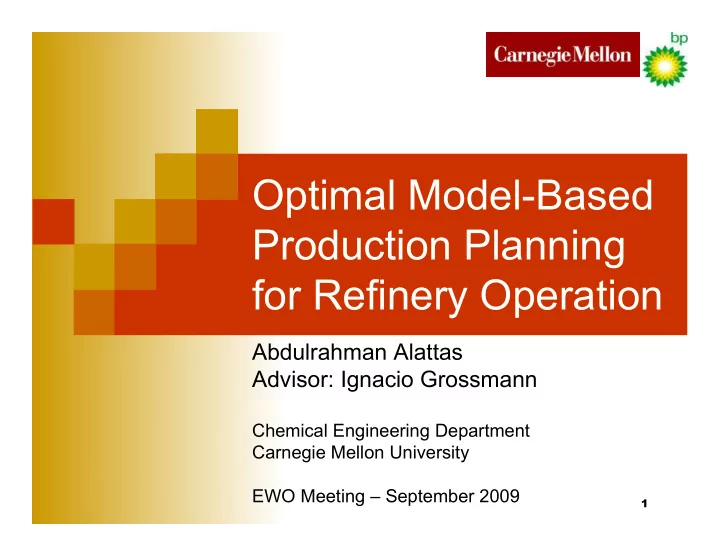

Optimal Model-Based Production Planning for Refinery Operation Abdulrahman Alattas Advisor: Ignacio Grossmann Chemical Engineering Department Carnegie Mellon University EWO Meeting – September 2009 1
Introduction Refinery production planning models Optimizing refinery operation Crude selection Maximizing profit; minimizing cost LP-based, linear process unit equations Current Project Collaboration with BP Refining Technology Goal: develop a refinery planning model with nonlinear process unit equations, and integrated scheduling elements 2
Problem Statement Typical Refinery Configuration ( Adapted from Aronofsky, 1978 ) Fuel gas butane SR Fuel gas Premium SR Naphtha Cat Ref Gasoline blending Reg. crude1 SR Gasoline CDU SR Distillate Distillate Distillate blending Cat Crack crude2 SR GO GO Gas oil blending SR Residuum Hydrotreatment 3 Treated Residuum
Problem Statement Information Given Refinery configuration: Process units Feedstock & Final Product Objective Select crude oils and quantities to process Maximizing profit single period time horizon 4
CDU Models Initial Focus on CDU SR Fuel gas Front end of the every refinery SR Naphtha LP models Fixed-yield equation: crude1 SR Gasoline CDU SR Distillate Swing cut equation: crude2 SR GO SR Residuum Typical Crude Distillation Unit (CDU) 5
Complexity of CDU CDU depends on steam stripping for fractionation, not reboilers Crude stability Multiple side streams Single column configuration Side strippers with steam stripping and reboilers Side condensers Typical Crude Distillation Column ( Gadalla et al, 2003 ) 6
CDU & Cascaded Columns Cascaded Columns Representation Typical Crude Distillation Column of a Crude Distillation Column 7 ( Gadalla et al, 2003 ) ( Gadalla et al, 2003 )
CDU Aggregate Model Original Aggregate Distillation Column Model V top,out Based on work of Caballero & D L top,in Grossmann, 1999 Principle Top Top and bottom integrated heat and Section mass exchangers around the feed location V top,in L top,out Constant flow in each section F Feed Pinch location is at the feed section V bot,out L bot,in Feasibility criteria Bottom V j , i L j , i ≤ K j , i i ∈ c omp , i ≤ LK, j ∈ l oc Section V j , total L j , total V j , i L j , i L bot,out ≥ K j , i i ∈ c omp , i ≥ HK, j ∈ l oc B V j , total L j , total V bot,in Temperature constraint T reb > T bot > T botfeed > T topfeed > T top > T cond 8
Aggregate Model Example Conventional cascaded columns example 4 columns Indirect sequence Feed 18 components (C3- C20) 9
Aggregate Model – Steam Distillation Column Complexity of adding steam D stripping 1 Lack of the reboiler and return to Top the column V topFeed Steam does not participate in the L topFeed F Feed equilibrium calculations V botFeed L botFeed Suitability of the section equimolal Bottom flowrate assumption Temperature profile is different n Column pressure and equilibrium Steam constant calculations B 10
Aggregate Model – Steam Distillation Column New model D Column split into 5 sections 1 Condenser, stage #1, top section, feed stage, bottom section, stage n Top Equilibrium equations applied to V topFeed L topFeed F Feed stage #1, feed stage and stage V botFeed L botFeed #n, excluding steam Bottom Mass & energy balances applied to all stages and n sections Steam Top product at the bubble point B 11
Modified Aggregate Model Example Distillate Water Feed cond C08,C10,C12 & C14 Temperature Profile Stage 1 Recovery #1 LK: C10, 74% HK: C12, 80% Top Top Results Correct temperature F Feed Feed profile Stage Peak at the feed stage Bottom Bottom n Stage Steam #n Bottom 350 400 450
Steam distillation cascaded columns Extension of the Condenser previous example Using 2 cascaded #1 Feed columns Top Bottom Col1 Section Model predicted the feed- Feed stage peak of the Col2 F Feed temperature profile Bottom Bottom Section col+1 #n V L Feed 290 340 390 440 stage L V col col+1 14
Steam distillation cascaded columns Further studies Impact of adding steam to the equilibrium equation Additional equilibrium constraints for the top and bottom sections Compare the results against simulation runs 15
Multi-period Planning Model Next phase in the development & key to the project Utilize available models Swing cuts, aggregate & FI models Preliminary development Addition of weekly demand and scheduled crude availability Handling refinery operation Crude change-overs Crude inventory & product inventory Identifying time resolution 16
Summary Research aims to build a nonlinear refinery planning & scheduling model Current focus on CDU CDU complexity Requires decomposition into cascaded columns Aggregate model approach conventional distillation columns steam-stripping distillation columns CDU fractionation index (FI) model Multi-period planning model Preliminary work started Key to scheduling & planning integration 17
Recommend
More recommend